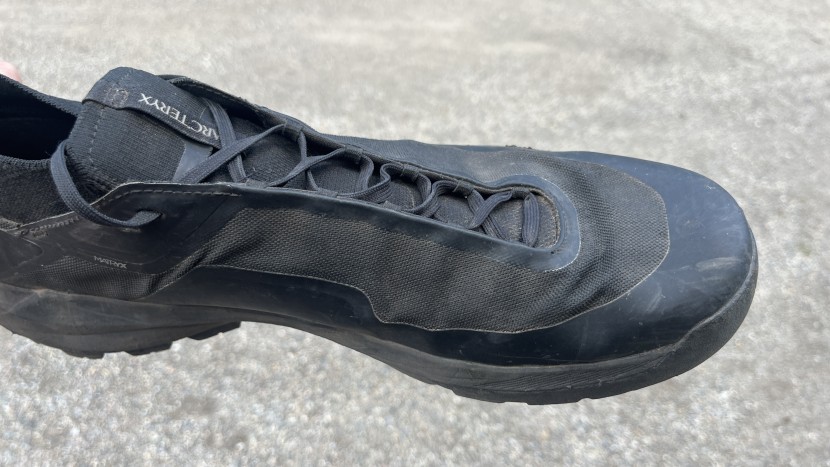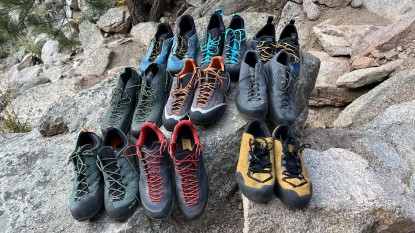
Our Verdict
Our Analysis and Test Results
These shoes perform better as a running shoe than as an approach shoe, but we still love them for technical scrambles where sticky rubber is a necessity.
Climbing Ability
The Vertex Alpine has surprisingly good climbing ability, considering that it is designed primarily as a running shoe. A secure heel cup and snug fit throughout the arch provide good feel, while the toe box is a bit wide and imprecise. The big toe edging area has thick rubber and a soft platform, making edging on small holds a dicey proposition. The Vibram sole is sticky and secure on slabby rock.
Our testers pushed these shoes to their limits on technical scrambling terrain and on classic mountain running circuits. While some approach shoes allow us to climb nearly as well as we can climb in rock climbing shoes, these shoes don't allow this kind of performance. For true rock climbing, the Vertex can't keep up. However, for technical runs and easy alpine scrambles that feature a few consequential moves of 5th class climbing, these shoes can handle the pressure, and on rocky, chunky trails, they lead the pack.
Hiking Comfort
The Arc'teryx Vertex Alpine is built for rugged and technical trails, and has to comfort to take you deep into the mountains and back. A thick padded EVA midsole provides plenty of cushion, while the Vibram XS Flash 2 rubber with aggressive tread pattern delivers excellent traction. The upper is thin enough to breath easily, and the lace pattern provides a secure fit. The tongue is soft and cushioned, making for a luxurious user experience.
This shoe has become our favorite for hiking, trail running, and low-tech approaches. Whenever we're packing for a trip that will involve lots of trail time, this shoe is on the pack list. It's a great choice for fast-moving backpackers and mountain runners alike.
Weight and Packability
These shoes are on the heavy side. At 27.5 ounces in size 13, these are among the heavier approach shoes on the market, and are much heavier than the best running shoes. While we don't mind the weight for shorter approaches, runs, and scrambles, our testers noticed the weight on days that exceeded about 6 miles (10 kilometers). They aren't that packable, and have a significant footprint when stuffed into a backpack. For these reasons, we don't use these shoes when approaching multi-pitch climbs that require carrying approach shoes up and over the route.
Thanks to their comfort, we do prefer to use these shoes whenever the approach involves benign travel or light scrambling, and where we can leave our shoes at the base. The upsides of hiking comfort and support outweigh the detractions posed by this shoe's heft, especially while carrying heavy climbing gear on rugged trails. Most of the time, these shoes are worth the weight.
Support
For a running shoe, the Vertex is surprisingly supportive. The thick EVA foam and TPU shank in the midsole provide a relatively stiff platform that tapers towards the toes. One of our favorite parts of the shoe is the stiff rubber heel rand, which feels stiffer than any other running shoe we've tested. A cushioned pad wraps around the top of the heel cavity, preventing heel rise. The result is a secure heel cup fit, which has benefits for both running and climbing performance. It can feel hard to pull the heel into the shoe the first time you put it on, similar to a climbing shoe.
While we wouldn't bring these shoes up a big wall, they are plenty supportive for schlepping heavy load to the base, and provide trustworthy security for long hikes on rough trails. And, for such thin upper material, they have remarkable support against rolled ankles. We would bring these shoes on remote treks and rugged long-distance hikes. They also make a great basecamp shoe after hiking into the backcountry.
Construction Quality
The Arc'teryx Vertex is well-built and has good construction quality. Vibram rubber lasts a long time, and the bottom of the polyester upper is protected by a thin rubber rand that extends around the circumference of the shoe. The stretchy polyester components of the upper are resistant to wear and tear, and the lace pattern distributes tension evenly, preventing too much pulling in any one place.
There is a lot of exposed EVA foam in the midsole, and in our experience, this is the usual place that that wear and tear will be begin to show first. These shoes aren't designed to be jammed into cracks regularly, which would pose a problem for durability in the upper near the toe box. That said, the rubber coating will prevent the occasional foot jam from doing too much damage.
Should You Buy the Arc'teryx Vertex Alpine?
This shoe is a godsend for any runner who likes to incorporate technical moves into their running itineraries. They crush miles on the trail and can smear when the moves get tenuous. They are most certainly not a replacement for climbing shoes, or even climbing-oriented approach shoes, but they are great for routes that involve some scrambling. If you are looking for a traditional approach shoe that climbs technical terrain with ease, these probably aren't the best choice, but if trail comfort is your biggest concern, these are a great option. However, they are extremely expensive, and budget-minded users can find similar performance elsewhere.
What Other Approach Shoes Should You Consider?
The Arc'teryx Vertex Alpine is a niche shoe for a very specific user. If you are looking for the best traditional approach shoe, we recommend the La Sportiva TX Guide for users with narrow and average-width feet, and the Scarpa Mescalito Planet for users with wide feet. The La Sportiva TX4 is just as capable as the Vertex for enduring long and rough approaches, but isn't a good choice for running. The La Sportiva TX2 Evo is the most capable approach shoe for technical climbing, and the Scarpa Crux provides the best value on the market for approach shoes.
| Awards | Best Approach and Trail Running Hybrid |
|---|---|
| Price | $230 List Check Amazon (on sale!) |
Overall Score  |
|
| Star Rating | |
| Bottom Line | This is the best hybrid shoe on the market for running and scrambling |
| Pros | Very comfortable, great for smearing, supportive |
| Cons | Expensive, heavy, doesn't edge well |
| Rating Categories | Arc'teryx Vertex Alpine |
| Climbing Ability (30%) | |
| Hiking Comfort (25%) | |
| Weight and Packability (20%) | |
| Support (15%) | |
| Construction Quality (10%) | |
| Specifications | Arc'teryx Vertex Alpine |
| Outsole | Vibram XS Flash 2 |
| Upper Material | Woven polyester |
| Weight (per pair) | 27.5 oz (size 13) |
| Width Options | Regular |
| Mid Height Available | No |
| Midsole | EVA/Polyolefin, TPU shank |












